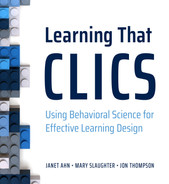CHAPTER 10
The Future of Workplace Learning
As we reflect on what we’ve learned, we’ve challenged ourselves to better understand the purpose of analysis in solving learning and workplace problems, and how all this positions us for the future. This book has been a catalyst to understand the changing nature of work. For us, three fundamental shifts have changed both the way we work and the way we live—a shift in integration, a shift in decision making, and a shift in meaning.
A Shift in Integration
Our expectations of work have been rebalanced within the broader context of our lives. While the idea of work-life balance has been around for some time, the meaning has shifted to work-life integration. The combination of a global pandemic, shifting workforce demographics, the acceleration of digitization, global warming, and social unrest have fueled the need for a rebalancing. Previously, balance was an attempt to compartmentalize work and life in both time and space. But the pandemic blew that construct apart, and life took a global center stage in ways we had never experienced collectively before. The messiness and chaos of living was on full display for all to see—and it shattered the artificial wall between work and life. Today, it almost seems absurd to think about how much energy we’ve historically invested in creating this artificial distinction.
A Shift in Decision Making
Our need for choice and flexibility is real, and our decisions have become more deliberate. Along with rebalancing comes the increased responsibility for planning and becoming more purposeful in our decisions. Reorienting ourselves to hybrid work as the norm means rethinking just about everything, both for individuals and organizations.
Employee experiences (EX) are being redesigned to address five core elements: when I work, where I work, how I work, with whom I work, and why I work. Each of these EX elements requires decisions on the part of the individual, team, and larger organization. And the most striking dynamic is these decisions cannot be made in isolation from one another. To foster a successful hybrid work environment requires more communication and more agility than legacy virtual environments. Our long-standing assumptions about the value of an office as a physical destination have been called into question. At the same time, our awareness of our need for social connectedness and personal relationships has never been greater. Creating new work environments that blend the best of virtual with the best of in-office to create a new category of purposeful, hybrid work is the transformation under way.
A Shift in Meaning
Our humanity is core to happiness.
Perhaps this may be the most important and lasting shift we are experiencing, as it is a shift in values. Programs about well-being, mindfulness, and stress reduction were the pre-pandemic warning signs that something needed to change. The saying, “Change doesn’t happen until the pain of staying the same exceeds the pain of making a change” certainly applies to the world of work. The volume and acceleration of information and technology over the last several decades reached an unsustainable tipping point. We’re not computers, we’re humans. It’s time to embrace our humanity—with all the insights, emotions, joys, and challenges that brings—by making work a more robust and engaging place to invest our limited time.
How Do These Shifts Impact Workplace Learning?
Current-day industry research points to rapidly changing employee expectations, which in turn are challenging companies to rethink their employment brand and employee value proposition. The desire for greater choice and flexibility is likely here to stay, impacting when, how, and where learning is consumed. Learning can be a powerful vehicle to foster lasting professional relationships within organizations, the kind of relationships that create strong bonds between individuals and with the organization itself. Industry research consistently shows a strong correlation between investing in talent development and the increased strength of cultural norms as well as higher levels of engagement. So-called soft skills, such as demonstrating empathy, building trust, and collaboration, are no longer considered discretionary, but are now seen as critical capabilities. In short, the role of learning has a golden opportunity to support rebalancing life, enabling choice, and fostering meaning at work.
Our Call to Action: Make Learning More Human-Centric
Behavioral science relies on empirical data that informs our understanding about how humans think, feel, behave, and communicate. To achieve lasting learning, we believe it all starts with understanding human psychology—how people process, retain, and apply learning in their everyday work environments. Without factoring in these realities, behavior change at scale will remain unnecessarily difficult. The long-standing push to promote organizational rather than behavioral science as the solution to human problems is flawed, as it relies on big data, market trends, and the “wisdom” of the crowd. While all these data sources can be useful, they ignore the role and impact of the human brain. The fields of social science and neuroscience are bridging the gap between organizational instincts and human behaviors. Applying social science insights to the world of work is a predictable path to achieving behavior change at scale. Once we appreciate how our brains learn, our ability to conduct a CLICS analysis can promote giant leaps forward, ensuring learning that lasts.
